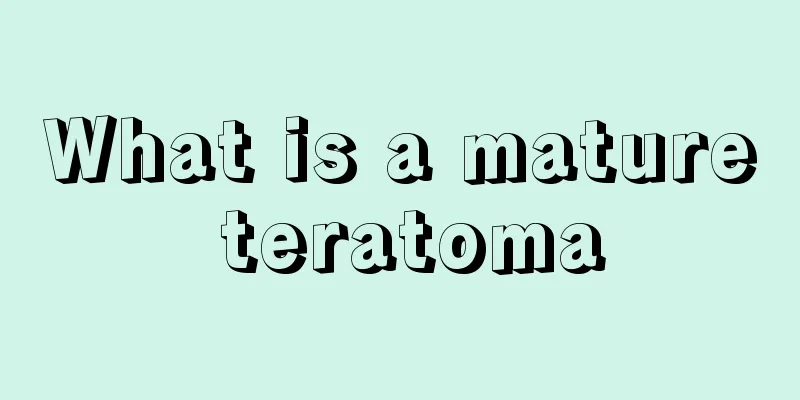What is a mature teratoma

|
What is a mature teratoma? Teratomas can occur in the central nervous system, but they are relatively rare. If such tumors are small or non-functional, they usually have no specific clinical manifestations. Teratomas in the spinal canal are often accompanied by various nerve compression symptoms. Let's introduce what a mature teratoma is. Mature teratoma is a benign teratoma, which comes in two types: cystic and solid. 1. Mature cystic teratoma is a benign cystic teratoma. This tumor is mostly composed of skin appendages of ectoderm origin and is also called dermoid cyst. It can occur in women of any age, from infants to elderly women. Gross examination: Most of them occur on one side, and less often on both sides. The size of the tumor varies, ranging from 0.3era to more than 45cm in diameter; more than half of them are 6 to 10cm in diameter, round or lobed, with a smooth surface, grayish white, and the cystic cavity is soft and elastic. Most of the cut surfaces are unilocular, and a few are multilocular, filled with a mixture of yellow greasy substances, keratinized substances and hair; the cyst walls are relatively smooth, and a solid area protrudes into the cystic cavity at a certain point, which is grayish white and often has hair, called the "head knot", which is as small as a bean or as large as a child's head. The "head knot" is often fat, bone, and cartilage, and one or several intact teeth and irregular bone pieces or well-developed bones can be seen. Occasionally, organ-like structures such as parts of the intestine, trachea, and even fetal limbs can be seen. Light microscopic examination: the cyst wall is lined with various mature epithelia, including squamous epithelium, sebaceous glands, sweat glands, and hair; mature bone, cartilage, brain tissue, glial tissue, retina, choroid, ganglion, etc., as well as foreign body giant cell reaction. 2. Mature solid teratoma is rare. The tumor is grayish white with a smooth surface, mainly solid, with small cysts formed in between, and is composed of various mature tissues from three germ layers. It is necessary to obtain sufficient tissue to exclude immature components. 3. Fetal teratoma is rare, with only fetal-like components in the teratoma. Hydrocephalus, toes, feet, eyes, teeth, penis, etc. can be seen. This type of teratoma must be distinguished from parasitic fetuses and old ectopic pregnancies in the fetus. 4. Malignant transformation of mature teratoma Any component of mature cystic teratoma can become malignant, with a malignancy rate of 2% to 4%. It mostly occurs in postmenopausal women, with an average age of 50.6 years old, and most of them are squamous cell carcinomas, while adenocarcinomas, sarcomas, and carcinosarcomas are less common. Gross examination: The tumor is larger than mature cystic teratoma, with an average diameter of 11 cm, grayish white, shiny, and smooth. If the malignant components of the tumor infiltrate and penetrate the capsule, they often adhere to the surrounding tissues and organs. Malignant changes are mostly in the head knot area, at which time the head knot becomes rough, mushroom-shaped or cauliflower-shaped, and the tissue is brittle; when it grows rapidly, the malignant tissue can fill the entire cyst cavity and can be easily mistaken for an immature teratoma. More tissues must be taken to find the remains of the original cyst cavity. The malignant transformation of mature teratoma is more common in epithelial components. Light microscopic examination: squamous cell carcinoma is the most common, about 90%. If the malignant transformation is limited to the epithelial layer, it is like general squamous cell carcinoma in situ, but invasive carcinoma is the most common, with different degrees of differentiation, and high differentiation accounts for about 1/2. In addition, there may be rare adenocarcinoma, sarcoma, carcinosarcoma and extremely rare malignant melanoma, carcinoid, neuroblastoma, and even rare extramammary Paget's disease. The probability of malignant transformation of all three germ layers is extremely low, and it needs to be distinguished from immature teratoma. The key point is that the malignant can have transitional lesions from mature tissue to cancerous tissue, while immature teratoma does not have transitional lesions, but it is difficult to distinguish in practice, especially when the range of malignant transformation is wide. |
<<: Can Traditional Chinese Medicine cure teratoma?
>>: What are the dietary requirements for teratoma
Recommend
What season is best for taking a bath?
A year is divided into four seasons, and the diff...
What are the symptoms of lymphoma? Can Chinese medicine treat it well?
Cancer is one of the important diseases in modern...
What are the causes of myocardial infarction
Myocardial infarction is a common heart disease, ...
What is the normal value of alt
The alt value represents the function of the huma...
Where is protein synthesis site?
Do you know what the nutrition that the human bod...
Can uterine cancer be passed down to the next generation?
If you have uterine cancer, you may ask if uterin...
Briefly explain the common symptoms of bone cancer
Bone cancer is a tumor disease that causes great ...
What are the effects and functions of aconite
The efficacy and function of aconite are mainly m...
How to remove dirt from your body when taking a bath
Many people take a bath every day, but every time...
It hurts when I press on both sides of the back of my head
Many friends will find that they have a headache ...
How to lighten facial spots, 4 little tips
As women age, they will have some spots on their ...
Is breast conservation plus sentinel therapy a treatment for early breast cancer?
Breast-conserving surgery plus sentinel surgery i...
What are the benefits of adding salt to brushing your teeth
Regardless of gender, age or status, brushing tee...
Specific introduction: Clinical manifestations of uterine cancer
Uterine cancer is one of the diseases that female...
Is high blood sugar scary?
High blood sugar is a common condition in our liv...









